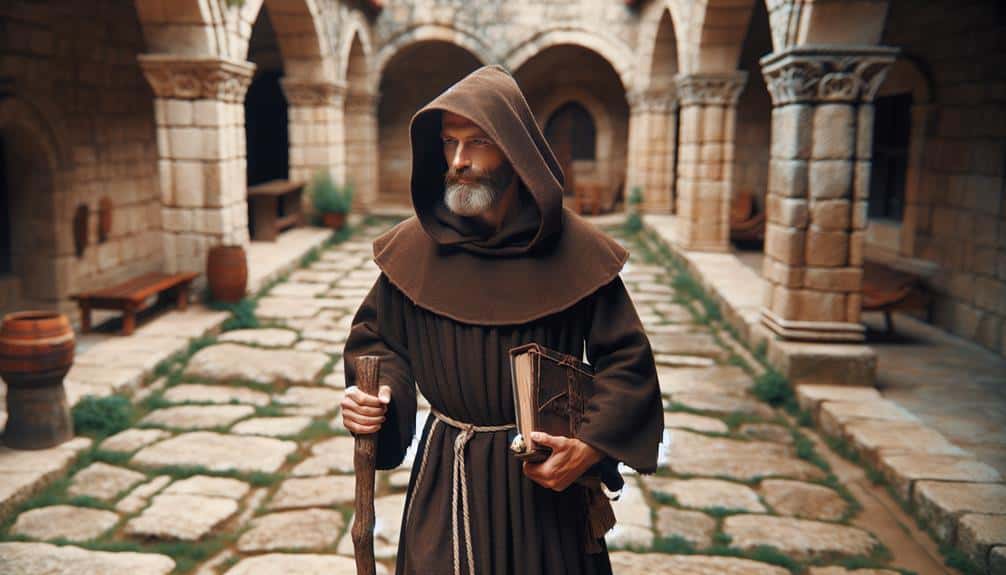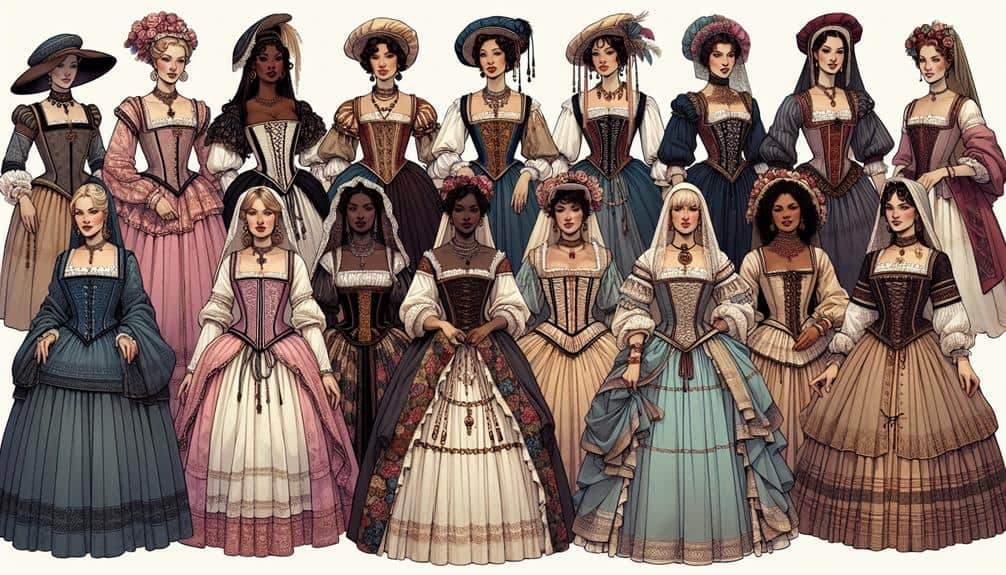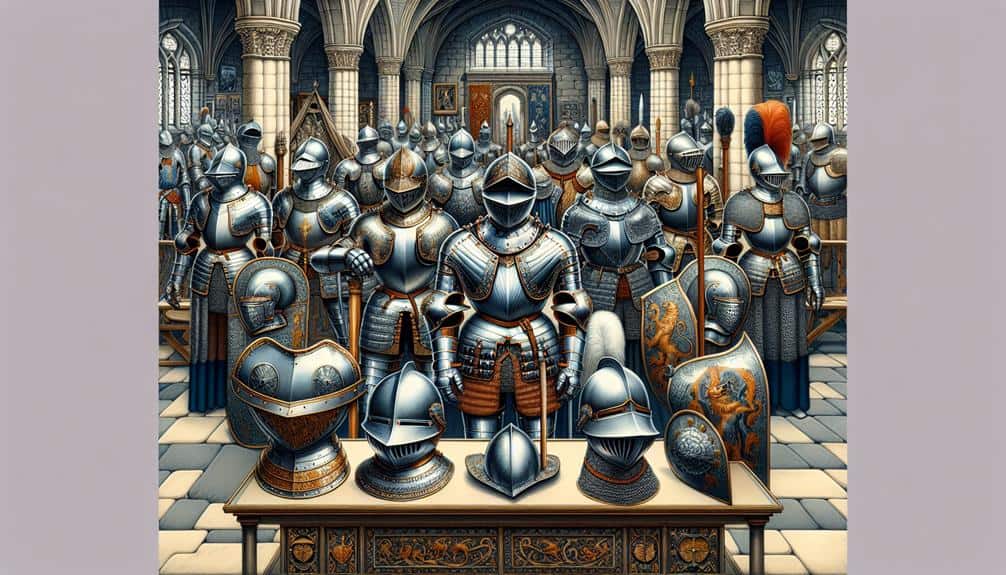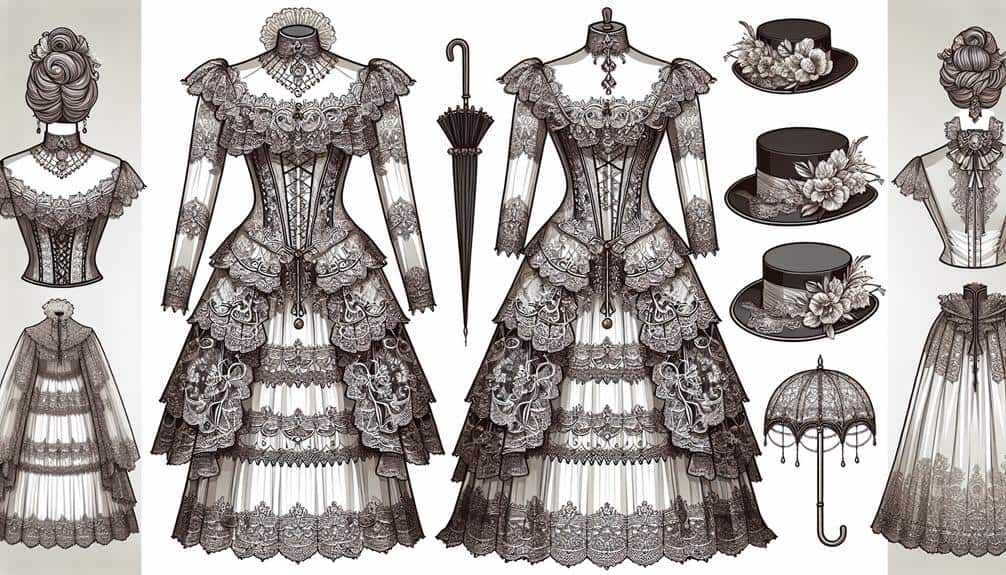Imagine stepping into a dimly lit medieval monastery, the scent of incense lingering in the air as hooded figures move about in their distinctive robes.
The intricate history and symbolism behind these garments are as fascinating as they are mysterious. From the origins of monk robes to the materials used and the colors representing different virtues, each aspect tells a story of devotion and tradition.
As you explore the world of medieval monk habits, you'll uncover a wealth of knowledge that sheds light on a timeless tradition still revered today.
Key Takeaways
- Symbolism of humility, devotion, and simplicity
- Diverse regional variations and historical influences
- Focus on comfort, durability, and historical accuracy
- Modern adaptations in cosplay for authenticity
Origins of Monk Robes
The origins of monk robes can be traced back to the early days of monasticism when simplicity and practicality were prioritized in religious attire. In the context of medieval fashion, monk robes emerged as a symbol of humility and dedication to a life of spiritual devotion. During this period, elaborate clothing was eschewed in favor of plain and unadorned garments, reflecting the values of austerity and renunciation of worldly pleasures.
Monks wore robes made from durable, natural fabrics such as wool or linen, which were easy to maintain and suited the simple lifestyle they led. The design of the robes was also influenced by the need for ease of movement during manual labor and daily activities within the monastery. These garments were typically loose-fitting and comfortable, allowing monks to focus on their prayers and duties without distraction.
In the domain of religious attire, monk robes held a significant place, symbolizing the monk's commitment to a life of poverty, chastity, and obedience. The practicality and symbolism embedded in the design of these robes became integral to the identity of monks in the medieval period.
Types of Monk Habits
Embracing a variety of styles and designs, monk habits serve as distinctive garments that reflect the diverse traditions and practices within monastic communities. When exploring the types of monk habits, fabric choices play a significant role in determining the comfort and durability of the garment. Different monastic orders may opt for fabrics like wool for warmth, linen for breathability, or silk for special occasions. Additionally, embroidery techniques are often used to embellish the habits, with intricate patterns and symbols adding depth to the garments.
Regional variations also contribute to the distinctiveness of monk habits. Different monastic communities around the world have developed unique styles influenced by their geographical locations and historical backgrounds. For example, the habits worn by Cistercian monks are simple and white, reflecting their commitment to austerity, while Benedictine monks often wear black habits as a sign of humility and penance. These historical influences have shaped the evolution of monk habits, highlighting the rich tapestry of traditions within monastic life.
Colors and Symbolism
Reflecting the spiritual significance and historical traditions, the colors and symbols found in medieval monk habits convey profound meanings within monastic communities. Each color used in monk robes holds symbolic significance, with deep cultural roots. For instance, the most common colors seen in medieval monk habits were black, white, brown, and grey.
Black symbolized humility, penance, and detachment from worldly desires. White represented purity, simplicity, and light, reflecting the monk's commitment to leading a blameless life. Brown denoted poverty, humility, and a connection to the earth, emphasizing the monk's vow of poverty. Grey signified modesty, respect, and reflection, encouraging monks to lead a contemplative life.
The symbols embroidered or woven onto the habits also held immense cultural significance, often representing virtues, religious beliefs, or the monastic order to which the monk belonged. These colors and symbols not only adorned the monk's attire but also served as constant reminders of their spiritual commitments and the values they upheld within their communities.
Materials and Construction
In crafting medieval monk robes, the choice of materials and the meticulous construction process played a pivotal role in ensuring the garments' durability and symbolic significance. Fabric choices were important in replicating historical accuracy. Monks typically wore garments made from natural fibers such as wool or linen, reflecting simplicity and humility. These fabrics were sturdy, breathable, and could withstand the rigors of daily wear.
Stitching techniques were another essential aspect. Monks often used basic stitching methods like running stitches or backstitches. These techniques not only held the garments together but also added to their authenticity. The construction of monk robes involved precise measurements and careful assembly to achieve the desired draping and fit.
While historical accuracy is paramount for reenactments or period dramas, modern adaptations of monk robes may involve using more accessible materials like cotton blends for comfort and ease of care. However, the essence of the traditional fabric choices and stitching techniques remains important to capture the essence and symbolism of medieval monk attire.
Monk Robes in Modern Cosplay
For those delving into modern cosplay, incorporating monk robes can add an element of historical mystique and authenticity to your character portrayal. In today's cosplay trends, the influence of medieval fashion, including monk robes, has gained popularity for its unique and intricate designs.
When creating a monk-inspired cosplay outfit, consider the traditional features of monk robes, such as the loose, floor-length garments with long sleeves and hoods. To enhance the historical accuracy of your costume, opt for earthy tones like brown, beige, or gray, which are reminiscent of the natural dyes used in medieval clothing.
Pay attention to the details like rope belts or sandals to complete the look of a medieval monk. Modern cosplay allows for creative interpretations, so feel free to incorporate personal touches while staying true to the essence of medieval monk attire.
Frequently Asked Questions
How Did the Design of Medieval Monk Robes Evolve Over Time?
As time passed, medieval monk robes evolved in design, incorporating various materials, styles, and symbolism. The garments transformed gradually, reflecting changes in religious practices and societal norms, ultimately becoming iconic symbols of devotion and humility.
Were Monk Robes Always Made of Plain, Simple Materials, or Were There Instances of More Elaborate Designs?
Plunge deeper into the world of medieval monk robes to uncover astonishing truths about their elaborate embellishments. Discover how luxurious fabrics intertwined with symbolic motifs transformed plain attire into ceremonial masterpieces without compromising practical functionality.
Did Monks Have Specific Rules or Guidelines for How to Wear Their Robes in Different Situations?
When it comes to monk attire etiquette, there were specific rules governing how monks wore their traditional garments. Depending on the occasion or activity, monks followed guidelines on how to properly dress, ensuring reverence and respect.
Were There Any Significant Differences in Monk Habits Between Different Religious Orders or Regions?
In medieval times, monk habits varied greatly due to regional influences and specific rules of religious orders. Regional variations in styles and materials were common, while distinctions between orders were evident in the design and color of their habits.
How Did Monks Care for and Maintain Their Robes to Ensure Longevity?
To confirm longevity, monks cared for robes meticulously. Maintenance techniques included gentle hand-washing, patching tears with precision, and strategic storage to prevent mold. Fabric care involved using natural remedies, while preservation tips emphasized airing out garments regularly.



